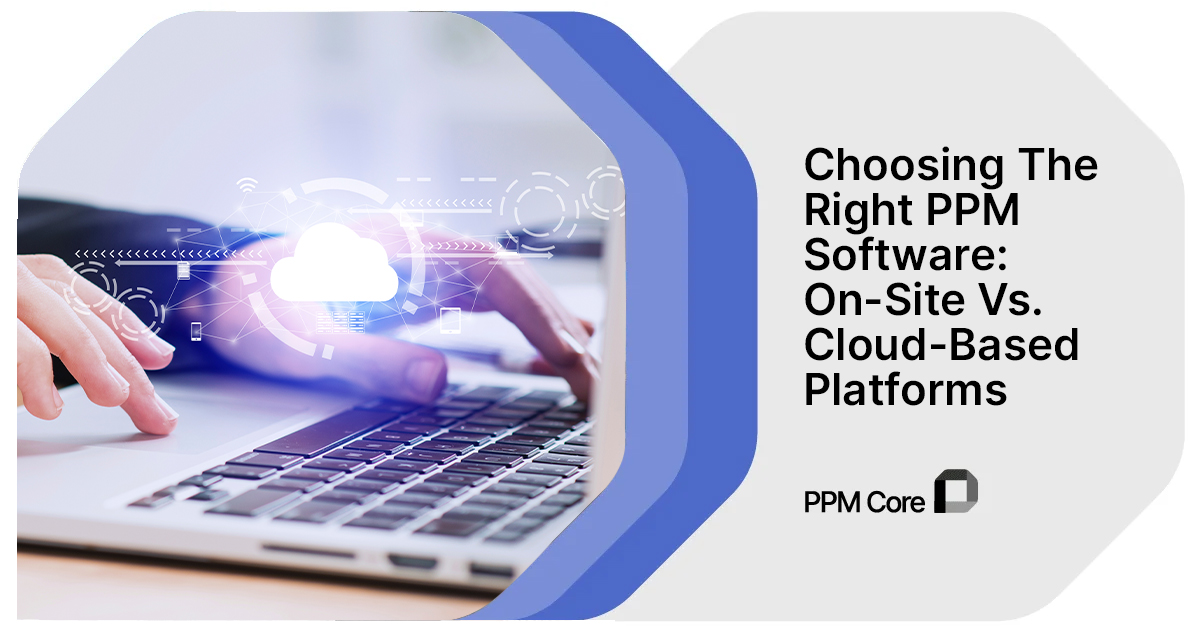When organizations embark on the journey of selecting project portfolio management (PPM) software, a pivotal decision between on-site and cloud-based platforms looms large. This choice extends beyond the deployment model, encompassing critical aspects of installation, management, and accessibility.
On-Site PPM Solution: A Comprehensive Approach
Delving into the intricacies of on-site PPM solutions reveals a comprehensive approach that places the entire infrastructure and data management squarely within the organization’s control.
Installation and Infrastructure Management
The meticulous process of setting up servers, emails, networks, and storage unfolds within the secure confines of the organization’s data center.
Pros and Cons of On-Site PPM
Pros:
- Complete Control: Empowering organizations with absolute control over infrastructure and sensitive project data.
- Data Security: Ensuring a heightened sense of data security aligning with organizational privacy policies.
Cons:
- Upfront Costs: Significantly higher initial investment covering hardware, software licenses, and skilled IT support.
- Resource-Intensive Implementation: Demanding substantial organizational resources and time for seamless integration.
Cloud PPM Solution: The Offsite Advantage
Contrasting with on-site solutions, cloud-based PPM solutions leverage remote servers over the internet, presenting a dynamic and scalable framework.
Operational Flexibility and Scalability
This offsite approach facilitates unparalleled flexibility, allowing organizations to adapt swiftly to changing project requirements and business landscapes. The scalable nature ensures alignment with project demands.
Managed Services by Third Party
Entrusting the backend operations to a third-party operator allows organizations to focus more on strategic aspects of project management, relying on experts for system maintenance and updates.
Balancing the Equation: Financial Feasibility
Delving into the financial aspects, on-site PPM software involves higher upfront costs, covering IT support staff, in-house server hardware, and software licenses. In contrast, cloud PPM requires ongoing payments but might offer a more predictable cost structure over time.
Customization and Integration Dynamics
Customization and integration are pivotal aspects in the realm of project portfolio management (PPM), influencing the adaptability of the software to an organization’s specific requirements.
On-Site Solutions: A Deep Dive into Customization
On-site PPM solutions offer a high degree of customization, allowing organizations to fine-tune the software according to their unique workflows and processes. This granular control is particularly beneficial for industries with specialized project management requirements. The ability to shape the software to align seamlessly with existing systems provides a level of control that some organizations find indispensable.
Cloud Solutions: Striking a Balance with Standardization
In contrast, cloud-based PPM solutions, while providing customization options, often operate within a more standardized framework. This can be advantageous for organizations seeking a balance between flexibility and standardized processes. Cloud solutions typically offer a range of configuration options, enabling users to adapt the software to their needs without the same level of granularity as on-site solutions.
Integration Capabilities Across the Board

Do you find this article interesting?
Subscribe to our Newsletter for updates on the latest blog articles.
Both on-site and cloud PPM solutions recognize the importance of integration with other tools and systems. Application Programming Interfaces (APIs) and integration capabilities ensure seamless connectivity with popular project management tools, CRMs, and enterprise resource planning (ERP) systems. However, the depth and ease of integration can vary, prompting organizations to carefully evaluate how well a PPM solution aligns with their existing technology stack.
Balancing Act for Optimal Results
Finding the right balance between customization and integration is key. Organizations should assess their specific project management requirements, considering the need for tailored workflows and the ability to integrate with existing tools. Striking this balance ensures that the selected PPM solution becomes an asset that enhances efficiency rather than a rigid system that constrains processes.
Data Security in Focus
Ensuring the security of project data is a critical consideration in PPM, with both on-site and cloud solutions implementing robust measures to protect sensitive information.
On-Site Solutions: Fortifying Internal Defenses
The on-site approach to PPM inherently offers a sense of control over data security. Project information resides within the organization’s physical premises, subject to internal security protocols and backup policies. This setup aligns closely with industries that prioritize having direct oversight and management of their data, such as those operating under strict regulatory frameworks.
Cloud Solutions: Rigorous Security Measures
Cloud-based PPM solutions, while operating offsite, implement rigorous security measures to safeguard project information. Reputable Software as a Service (SaaS) providers adhere to industry standards and certifications, employing encryption protocols, regular security audits, and access controls. The centralized nature of cloud security allows for swift responses to emerging threats.
Addressing Concerns in the Cloud
Despite the advancements in cloud security, organizations may still harbor concerns, especially in industries with stringent privacy regulations. Cloud PPM providers actively address these concerns by providing transparent security documentation, compliance certifications, and regular updates on security measures. This proactive approach aims to instill confidence in users about the safety of their project data.
User Education and Compliance
Both on-site and cloud solutions emphasize the importance of user education and compliance with security protocols. Training programs, regular security updates, and access controls are integral components of maintaining a secure PPM environment, regardless of the deployment model.
Introducing PPM Core
Considering the complexities involved in choosing between on-premises and cloud-based project portfolio management (PPM) solutions, organizations may find a valuable middle ground with PPM Core. PPM Core offers a comprehensive cloud-based PPM platform that goes beyond conventional solutions.
Key Advantages of PPM Core
- Seamless Collaboration: Fostering a collaborative environment connecting project stakeholders, enhancing communication and decision-making.
- Universal Viewer: Providing a universal viewer for project data access, ensuring inclusivity.
- Scalability and Rapid Implementation: Designed to be scalable, facilitating quick onboarding and adaptation to changing project needs.
- Democratized Data Access: Ensuring project data accessibility for all participants, promoting transparency.
- Predictable Costs: With a monthly fee structure, PPM Core provides cost predictability, eliminating unforeseen expenses.
- Zero Onboarding Efforts: As a cloud-based solution, PPM Core requires zero onboarding efforts, allowing organizations to focus on projects rather than infrastructure management.
Final Considerations: Making an Informed Decision
In the on-site vs. cloud debate, aligning with the organization’s needs is paramount. Conducting a Total Cost of Ownership (TCO) analysis, assessing customization requirements, integration needs, and data security standards are crucial steps before choosing a PPM solution.
In conclusion, recognizing that both on-site and cloud PPM solutions have their merits and drawbacks underscores the importance of tailoring the choice to the organization’s unique needs. A nuanced evaluation against specific requirements is imperative, as limiting the organization to a single platform can incur long-term costs.

